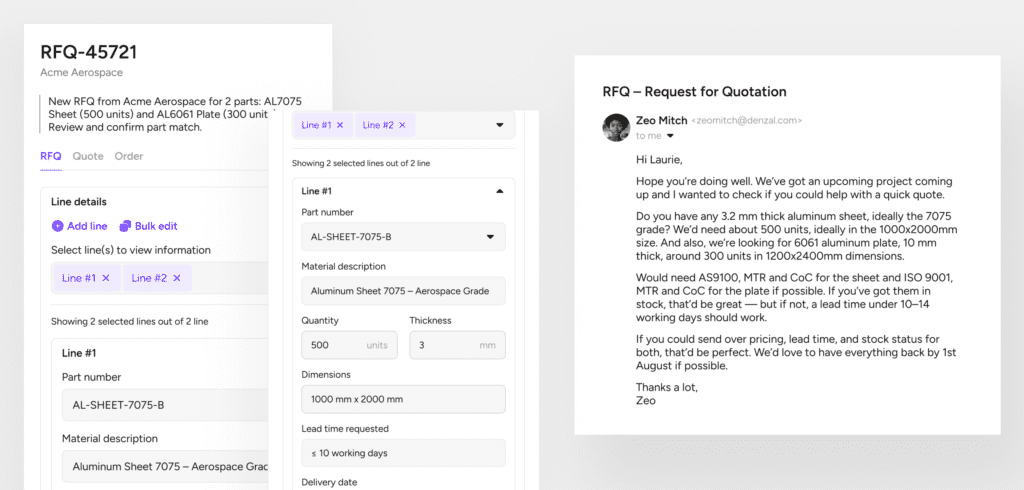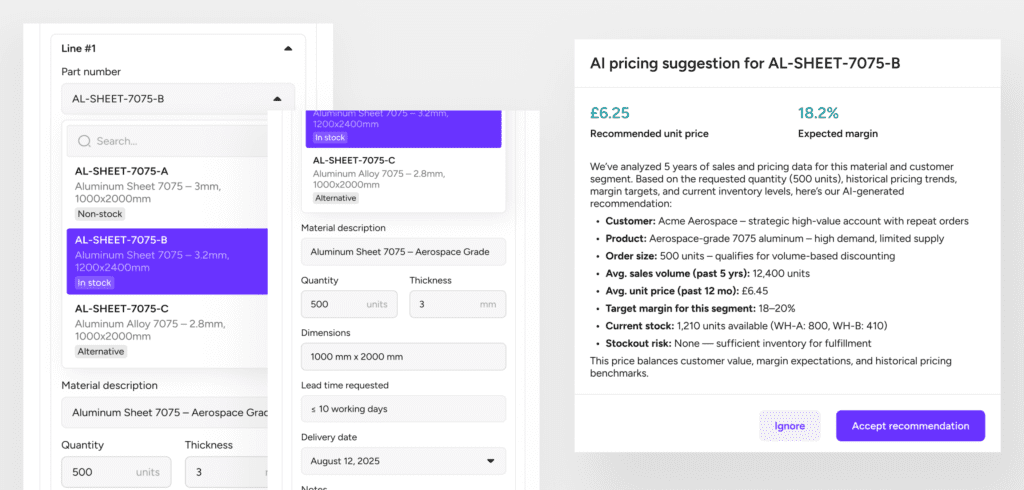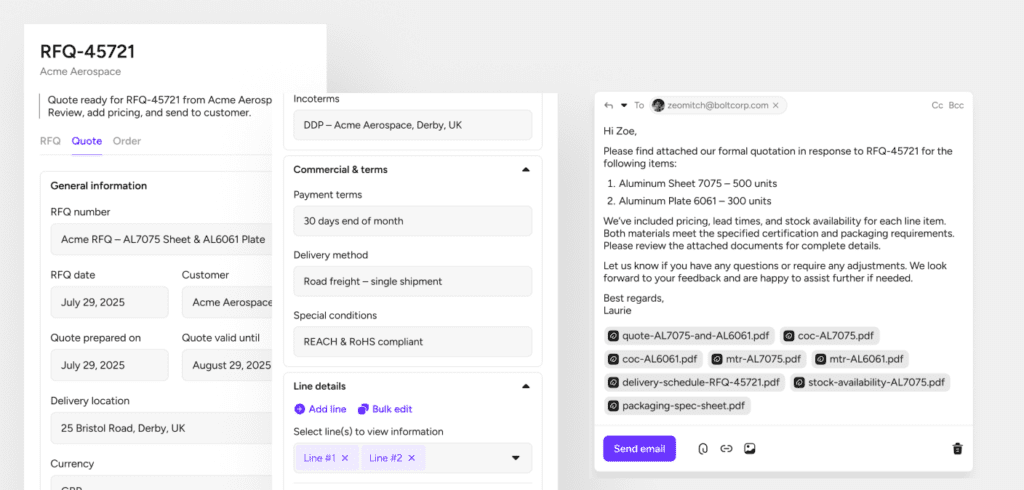
ANNOUNCEMENT
QAD Redzone acquires Kavida — our Agents have joined the Champion AI family

Discover how AI agents are reshaping the manufacturing operating model

Hi, I’m Alison!
Share your details, and I’ll give you a call in minutes to see how we can assist.

How Distributors Can Automate Repeat Quotes & Free Their Sales Teams
Table of Contents
ToggleQuoting should be fast, accurate, and seamless—especially for repeat business. Yet many sales teams spend half their day churning out the same quotes for the same parts, over and over again.
This is a massive drain on productivity, throughput, and customer responsiveness.
With AI agents, distributors can now automate repeat quote generation end-to-end—from parsing inbound requests to generating the quote and drafting the customer email. The result? Sales productivity increases by 5X, response times shrink, and reps finally have time to sell, not type.
The Problem: Quoting Is Eating Into A Typical Sales Day
For many distributors, a large percentage of quotes are for repeat purchases—items customers buy over and over. Despite that, the quoting process remains entirely manual.
Every RFQ—whether it arrives by email, spreadsheet, or PDF—triggers a repetitive series of tasks. Even for familiar items, reps must treat each request like a new one.
The Admin Load Behind Every Quote
A typical repeat quote involves a long chain of manual steps:

Receive an email or RFQ from a customer.

Search for each part in the ERP system.

Retrieve pricing, lead time, and any customer-specific terms.

Build the quote, line-by-line—sometimes for 30–40 items at once.

Draft a professional response email.

Manually enter everything back into the ERP or CRM.
Now multiply that by dozens of quotes per week, and it’s clear: quoting is no longer a sales enablement task—it’s a full-time administrative burden.
Impact on Throughput and Productivity
Sales reps today spend 30–50% of their time managing quote requests for repeat orders. That’s time not spent talking to customers, managing accounts, or closing new business.
As quote volumes rise, throughput hits a ceiling. Teams grow slower, not faster. The real cost isn’t just time—it’s lost revenue.
The Opportunity: Automate What’s Repeatable, Free Sales Capacity
Repeat Quotes Are Perfect for Automation
The quoting process may be manual—but it’s not strategic. The inputs are predictable. The logic is consistent. The admin work is high, but the complexity is low.
- The same parts and materials are quoted over and over.
- Terms like customer-specific pricing or discounts rarely change.
- Every quote involves search, copy-paste, formatting, and email—on repeat.
- Customers expect fast turnaround for routine quotes.
That makes it an ideal candidate for automation.
What Sales Teams Should Be Doing
Reps should be spending time where it moves the needle:
Strategic deals and project-based sales
Account expansion and upselling
Building relationships with key customers
Driving roadmap alignment & long-term planning
Instead, they’re spending hours keying part numbers and copy-pasting prices.
How AI Agents Automate Quote Generation End-to-End
Recognizing and Reading the RFQ
AI agents built on LLMs can automatically read and interpret inbound quote requests. Whether it’s a structured spreadsheet or an unstructured email—“Can you send me pricing on 4x SS bolts?”—the agent understands the request.
It identifies the part(s), quantity, units, and any context about urgency or customer expectations.

Matching to ERP and Pulling the Right Data
Next, the agent maps the request to ERP data:
- Finds the correct part number.
- Retrieves current and historical pricing.
- Applies customer-specific discounts or terms.
- Checks availability or lead times.
This happens in seconds—even across dozens of line items.

Drafting and Sending the Quote
Once the data is collected, the agent:
- Builds a clean, line-item quote formatted to the company’s standards.
- Drafts a customer-facing email with clear pricing, terms, and next steps.
- Sends it automatically, or saves it for sales approval.
- Logs the activity in the ERP or CRM with full traceability.

Human-in-the-Loop for Oversight
The agent flags exceptions—such as missing pricing or ambiguous part numbers—for sales review. But even for standard, repeat quotes, teams can start by reviewing the agent’s work. Quotes can be saved as drafts, reviewed for accuracy, and edited before sending—giving reps full visibility and control in the early stages.
As confidence builds, the process can be fully automated for repeat quotes—allowing the agent to send responses directly while still flagging edge cases. Sales teams stay in control, with the flexibility to move from oversight to full autonomy at their own pace.
5X Throughput, Happier Customers
Freeing Up Sales Capacity
With quoting automated, sales reps can handle 5X more RFQs in the same time. Customers get faster responses. Teams get more done without hiring. Bottlenecks disappear.
Shifting Focus from Admin to Impact
Instead of spending half the day quoting, reps can spend their time:
-
Re-engaging dormant accounts.
-
Quoting complex, high-value opportunities.
-
Improving win rates through better follow-up.
In short: they start selling again.
Don’t Let Admin Bottleneck Your Sales Engine
Manual quoting may feel like just another admin task—but at scale, it’s a barrier to growth. Every minute spent repeating the same steps is a minute not spent growing the business.
AI agents eliminate that bottleneck. They automate the repetitive, standard quoting process end-to-end—accurately, fast, and without supervision.
The payoff is measurable: higher throughput, happier customers, and sales teams free to focus on what matters most.
Related articles

The Procurement Blueprint for Human-Centric Digital Innovation
Procurement leaders today need more than just efficient workflows—they need insights that drive smart decision-making. For decision makers...

Buffer Stock Is a Symptom of Blind Spots – How Agents Use Risk Analysis to Optimise Inventory
In supply chain circles, buffer stock is often seen as a smart move - a little extra product tucked away...

Microsoft Copilot Is Not an AI Strategy – How to Think About Horizontal vs Vertical AI Strategy
Enterprises that mistake Microsoft Copilot, or any other horizontal AI layer for a strategy, end up with...

